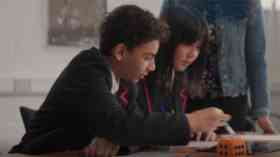
Why is it important to encourage girls into computing?
Technology affects every aspect of our lives – and delivers exciting career opportunities. Yet girls are still under-represented in computing. Julia Adamson, director of education at BCS, the Chartered Institute for IT, discusses how to engage girls, and why it’s important
Technology affects every field and it’s not just about computers or smartphones. Technology is about medicine, energy, space research, entertainment, transport, fashion and food.
So, it’s vital that technology includes everyone, that we are all empowered, skilled and knowledgeable users and consumers – and that particularly means getting girls involved in computing.
Let’s explore what we mean by computing. In schools, computing refers to a subject that is taught at every Key Stage and the computing curriculum is helping us to shape the ethical, accountable future-ready users and creators of technology.
Computing is like glitter. It gets everywhere. It’s in every part of life from our democracy to entertainment. Its sparkle lures us in. It’s found in the places you’d least expect and it’s almost impossible to get rid of.
And increasingly jobs in every sector will require ever-broader digital skills. Every citizen will need to build their digital competence to participate fully in society. Educators’ responsibility is to prepare young people as empowered, ethically informed, future-ready citizens and employees.
As part of that responsibility that means reaching significantly more girls.
Dropping the subject
Our school system gives girls and boys an equal opportunity to access the computing curriculum, but when students make subject choices that equality fades away. In fact, most students (85 per cent) drop computing at the first opportunity (at the end of Y9, aged 14). This is worse amongst females, c.97 per cent of all girls drop it.
Of the students that do opt to take a GCSE in computer science, only 22 per cent of the entries are from girls. IT vocational qualifications perform a little better from a gender perspective, around 35 per cent of entries are from girls.
When girls do choose to study computing qualifications, they outperform their male counterparts and this is found to be consistently true for GCSEs, vocational qualifications, A Levels and the new T Levels.
So what’s the reason for this? Are males and females fundamentally that different? Research suggests not. Are males born with some inherent computing ability? Research suggests not. Computing requires creativity, thinking skills, logic and an enquiring mind, all things that are abundant in females.
Are males more interested in computing? Whilst there’s no truth to this, some students will appreciate much more the context and the relevance of computing to their cultural and societal reality. So, how computing is taught, and the contexts through which it is taught, are much more important to some students, and this is particularly apparent in females.
Do we really need to worry that computer science is monocultural? Categorically, absolutely, yes. Let’s back to the glitter, everywhere, forever, everything. And let’s get back to technology, it is designed, developed, programmed and used by humans.
The systems that tech companies build and the kind of things we produce in mono-cultural teams, lead to voice recognition systems that are not responsive to female voices, face recognition systems that have major problems with black and ethnic minority faces, gender options that always start with male, and are usually binary, and a health tracking app which enables you to track your copper intake before it you can track your periods.
Tech and data can easily reflect or magnify implicit or explicit biases and discriminate against individuals, groups and demographics. We, therefore, need the people who are designing, developing, programming, and using tech to be diverse, representative of society, ethical, accountable, and competent.
Let’s talk about algorithms
The National Curriculum Programme of Study for five to seven-year-olds (key stage 1) says that pupils should be taught to understand what algorithms are and how they are implemented as programs on digital devices to following unambiguous instructions.
I’m sure there’s not a primary classroom in the country that hasn’t dabbled with the jam sandwich activity or laughed at Barefoot’s Crazy Characters.
Algorithms play a huge role in our lives. They can stop you getting a job, a mortgage, a credit card. They are not pure, transparent, or accountable. They hold the biases of the humans who work on them and the biases of the data they work with. It’s vital that users understand that algorithms present a particular view of the world.
Collaborative teaching approaches in STEM subjects have been shown to improve self-efficacy and achievement in girls. Pedagogical approaches can create a climate for building self-efficacy – so instead of writing code from scratch think about remixing collaboratively – focussed on improving something for a specific audience.
For example, move away from everyone using Scratch to get the cat to move across the screen to teams working on improving/changing a maths game to help younger students to practise multiplication facts in a fun way.
A BCS/YouGov survey in February this year found that 96 per cent of parents in England think that learning computing and information technology skills at school are important for their child’s future.
Advocating for computing
School leaders can advocate for computing and digital skills in several ways.
Firstly, make your KS1 – 3 curriculum interesting and relevant, enhance your curriculum offer with a range of enrichment opportunities including trips, competitions, clubs and projects.
Build a community of advocates in school which includes students, parents and local industry and invite advocates in from elsewhere such as your alumni and local employers.
Talk to your students about the economic benefits of a career in tech/ tech skilled careers.
Offer a range of computing courses and qualifications at KS4/5 including micro-courses.
Use the NCCE Computing Quality Framework to review your provision and get started on your journey including access to CPD and resources.
Encouraging girls on a computing pathway
We need to support and equip parents and carers to be able to support and encourage their daughters to engage. Research suggests that there are three key ingredients to encourage girls to choose a computing pathway.
The first is to believe computing is something you can do – someone has said you can do this (self-confidence is hard to develop and easy to knock).
The second is to believe computing is relevant to you – you can see the why, you can relate to the activity you’re doing in class, you can see how that relates to the real world.
And the last ingredient is to feel a sense of belonging; computing is for you and you belong there. This is a bit trickier but research suggests that this is the most important aspect.
Using innovation
It is only by delivering an inclusive computing education that we can create the empowered users and ethical creators of the future.
Sharon Cromie, UK regional director of the International Coalition of Girls’ Schools (ICGS) explained how UK state girls’ schools and members of the ICGS have developed innovative ways to encourage girls to take up computing.
She says: “Our schools have explicitly promoted the economic value of subjects such as mathematics and computing for girls’ future careers, and brought both traditional and non-traditional IT careers into sharp focus. They have trained teachers to do this and have increased work experience in digital fields and non-explicit digital fields such as medicine, health, environment.
“Perhaps the most innovative strategy adopted by some of our schools, is putting digital learning at the heart of the curriculum for all year groups, much like PE or RS.
This, alongside increasing numbers studying mathematics (including Core Maths), ensures all girls leave school able to code and apply computational thinking. Such innovative programmes, taught by specialist teachers and external female experts have led to increased uptake of A Level Computing and have cemented the message: every career now requires digital learning and schools are best placed to deliver it. It does, however, require more than offering GCSE and A Level Computer Science. Ultimately, digital learning may need to follow the same statutory pathway as PSHE.”
Latest News
08/01/2026 - 10:30
The government is launching a new app allowing students to view their GCSE results on their phones for the first time from this summer.
08/01/2026 - 09:45
Education Business LIVE has announced that Professor Samantha Twiselton OBE of Sheffield Hallam University will speak at the event in March 2026, delivering two thought-provoking sessions focused on initial teacher training and SEND provision.
07/01/2026 - 10:10
Solve for Tomorrow is a free, curriculum-linked programme which is mapped to Gatsby Benchmarks 4, 5, and 6, helping teachers embed careers education without adding to workload.
06/01/2026 - 10:24
London's universal free school meals programme has not led to improvements in pupil attainment during its first year, but has eased financial pressure and reduced stress for families.
05/01/2026 - 10:44
New regulations have come into force from today, banning adverts for unhealthy food and drinks before 9pm, and online at all times.







